Alzheimer's Disease: A Comprehensive Analysis of the Disorder
VerifiedAdded on 2023/06/10
|7
|2010
|405
Report
AI Summary
This report provides a detailed overview of Alzheimer's disease, an irreversible and progressive brain disorder that leads to memory loss and cognitive decline. It explores the disease's symptoms, which include difficulties with memory, reasoning, and behavior, and discusses the formation of plaques and tangles in the brain as key abnormalities. The report also delves into the various risk factors associated with Alzheimer's, such as increasing age, family history, and genetics, and highlights different treatment approaches, including cholinesterase inhibitors and memantine, along with supportive care strategies to enhance the patient's well-being and daily functioning. Furthermore, it emphasizes the importance of environmental modifications, exercises, and proper diet in managing the disease and slowing its progression, although it acknowledges that there is currently no cure.
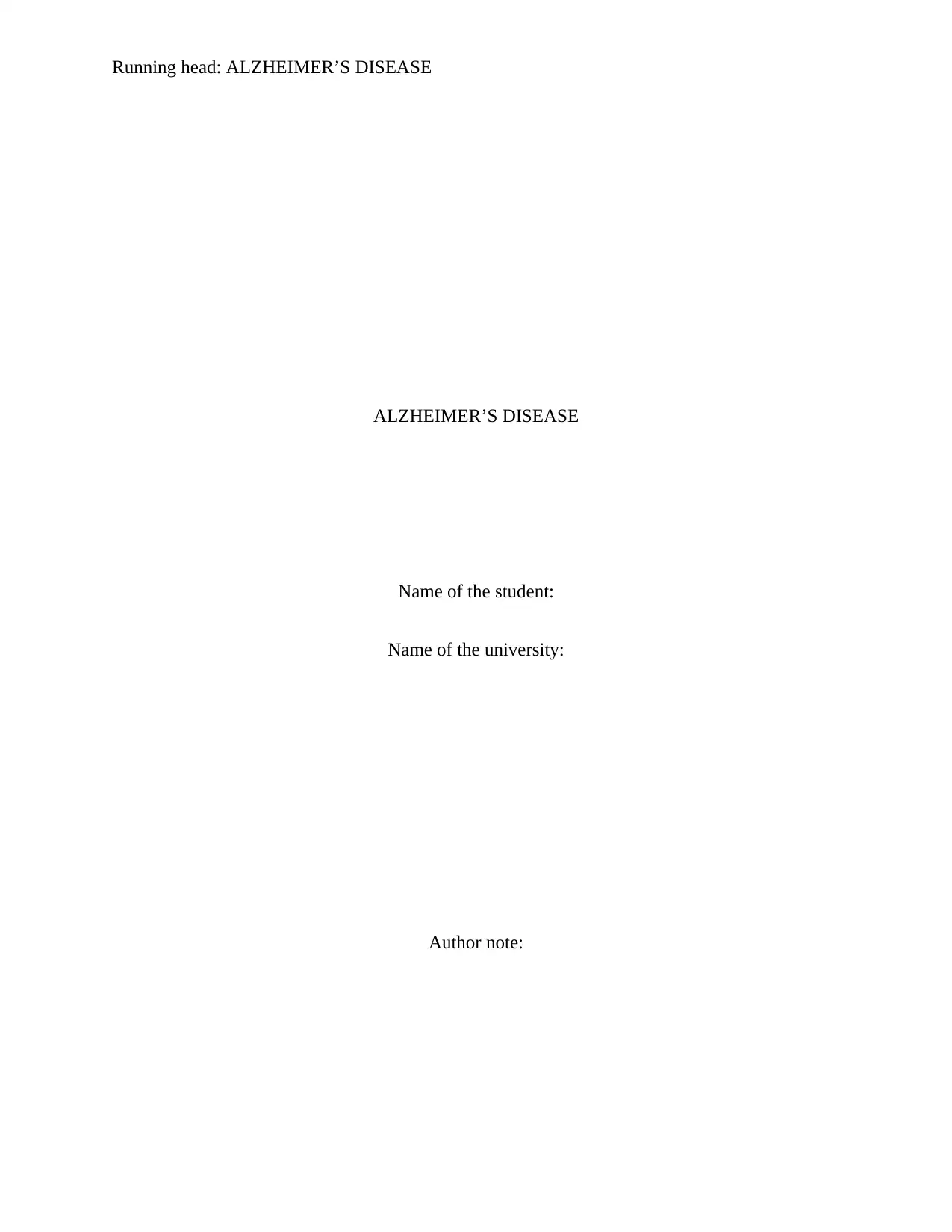
Running head: ALZHEIMER’S DISEASE
ALZHEIMER’S DISEASE
Name of the student:
Name of the university:
Author note:
ALZHEIMER’S DISEASE
Name of the student:
Name of the university:
Author note:
Paraphrase This Document
Need a fresh take? Get an instant paraphrase of this document with our AI Paraphraser
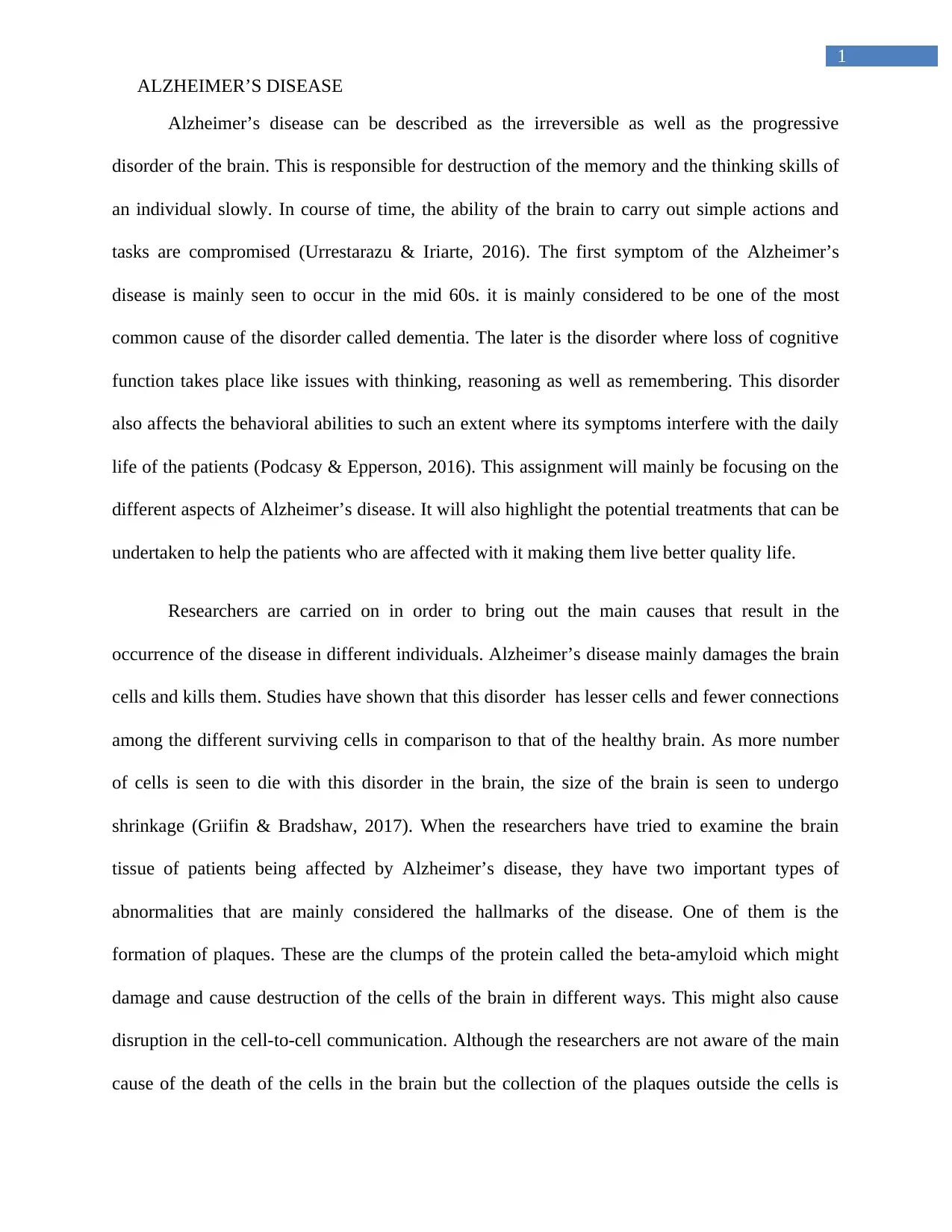
1
ALZHEIMER’S DISEASE
Alzheimer’s disease can be described as the irreversible as well as the progressive
disorder of the brain. This is responsible for destruction of the memory and the thinking skills of
an individual slowly. In course of time, the ability of the brain to carry out simple actions and
tasks are compromised (Urrestarazu & Iriarte, 2016). The first symptom of the Alzheimer’s
disease is mainly seen to occur in the mid 60s. it is mainly considered to be one of the most
common cause of the disorder called dementia. The later is the disorder where loss of cognitive
function takes place like issues with thinking, reasoning as well as remembering. This disorder
also affects the behavioral abilities to such an extent where its symptoms interfere with the daily
life of the patients (Podcasy & Epperson, 2016). This assignment will mainly be focusing on the
different aspects of Alzheimer’s disease. It will also highlight the potential treatments that can be
undertaken to help the patients who are affected with it making them live better quality life.
Researchers are carried on in order to bring out the main causes that result in the
occurrence of the disease in different individuals. Alzheimer’s disease mainly damages the brain
cells and kills them. Studies have shown that this disorder has lesser cells and fewer connections
among the different surviving cells in comparison to that of the healthy brain. As more number
of cells is seen to die with this disorder in the brain, the size of the brain is seen to undergo
shrinkage (Griifin & Bradshaw, 2017). When the researchers have tried to examine the brain
tissue of patients being affected by Alzheimer’s disease, they have two important types of
abnormalities that are mainly considered the hallmarks of the disease. One of them is the
formation of plaques. These are the clumps of the protein called the beta-amyloid which might
damage and cause destruction of the cells of the brain in different ways. This might also cause
disruption in the cell-to-cell communication. Although the researchers are not aware of the main
cause of the death of the cells in the brain but the collection of the plaques outside the cells is
ALZHEIMER’S DISEASE
Alzheimer’s disease can be described as the irreversible as well as the progressive
disorder of the brain. This is responsible for destruction of the memory and the thinking skills of
an individual slowly. In course of time, the ability of the brain to carry out simple actions and
tasks are compromised (Urrestarazu & Iriarte, 2016). The first symptom of the Alzheimer’s
disease is mainly seen to occur in the mid 60s. it is mainly considered to be one of the most
common cause of the disorder called dementia. The later is the disorder where loss of cognitive
function takes place like issues with thinking, reasoning as well as remembering. This disorder
also affects the behavioral abilities to such an extent where its symptoms interfere with the daily
life of the patients (Podcasy & Epperson, 2016). This assignment will mainly be focusing on the
different aspects of Alzheimer’s disease. It will also highlight the potential treatments that can be
undertaken to help the patients who are affected with it making them live better quality life.
Researchers are carried on in order to bring out the main causes that result in the
occurrence of the disease in different individuals. Alzheimer’s disease mainly damages the brain
cells and kills them. Studies have shown that this disorder has lesser cells and fewer connections
among the different surviving cells in comparison to that of the healthy brain. As more number
of cells is seen to die with this disorder in the brain, the size of the brain is seen to undergo
shrinkage (Griifin & Bradshaw, 2017). When the researchers have tried to examine the brain
tissue of patients being affected by Alzheimer’s disease, they have two important types of
abnormalities that are mainly considered the hallmarks of the disease. One of them is the
formation of plaques. These are the clumps of the protein called the beta-amyloid which might
damage and cause destruction of the cells of the brain in different ways. This might also cause
disruption in the cell-to-cell communication. Although the researchers are not aware of the main
cause of the death of the cells in the brain but the collection of the plaques outside the cells is
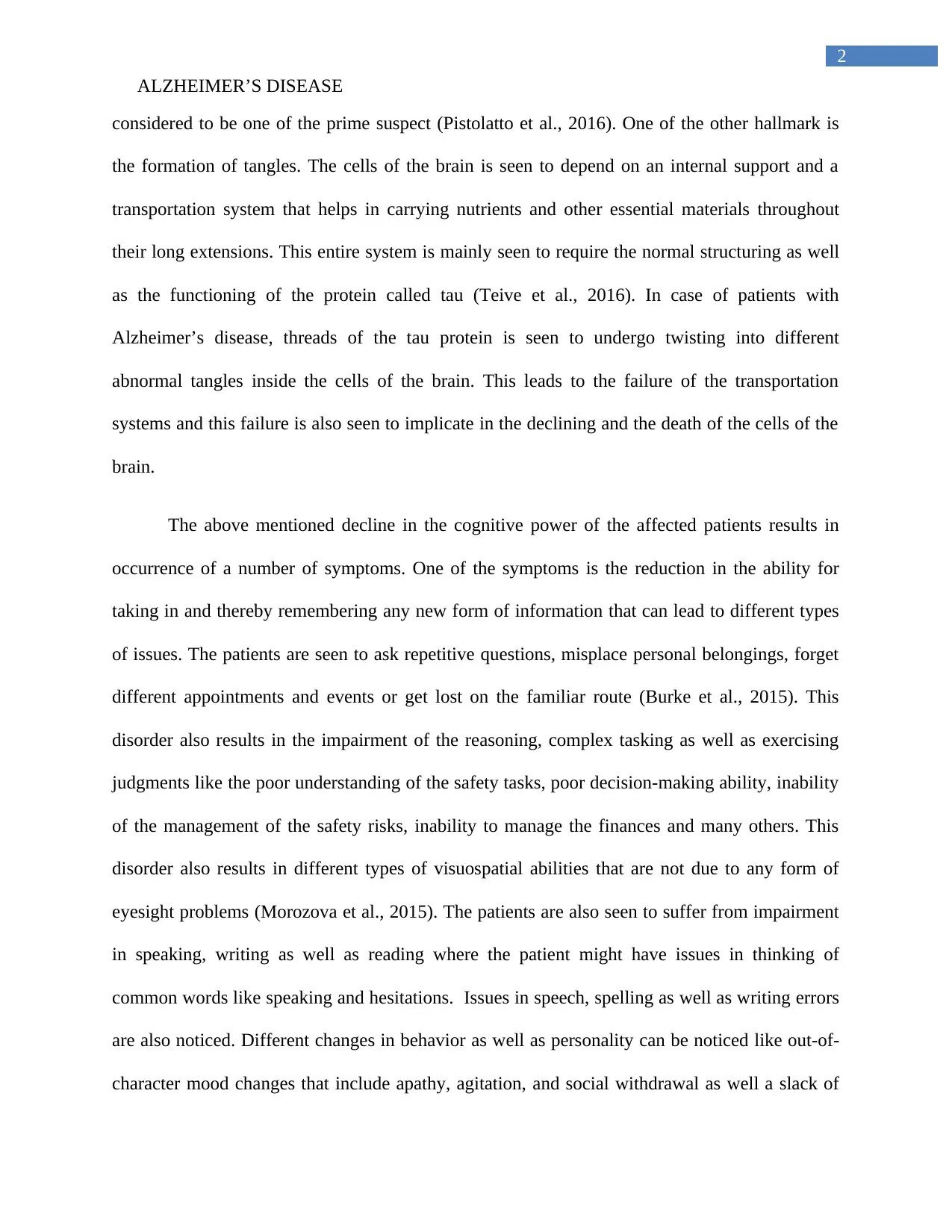
2
ALZHEIMER’S DISEASE
considered to be one of the prime suspect (Pistolatto et al., 2016). One of the other hallmark is
the formation of tangles. The cells of the brain is seen to depend on an internal support and a
transportation system that helps in carrying nutrients and other essential materials throughout
their long extensions. This entire system is mainly seen to require the normal structuring as well
as the functioning of the protein called tau (Teive et al., 2016). In case of patients with
Alzheimer’s disease, threads of the tau protein is seen to undergo twisting into different
abnormal tangles inside the cells of the brain. This leads to the failure of the transportation
systems and this failure is also seen to implicate in the declining and the death of the cells of the
brain.
The above mentioned decline in the cognitive power of the affected patients results in
occurrence of a number of symptoms. One of the symptoms is the reduction in the ability for
taking in and thereby remembering any new form of information that can lead to different types
of issues. The patients are seen to ask repetitive questions, misplace personal belongings, forget
different appointments and events or get lost on the familiar route (Burke et al., 2015). This
disorder also results in the impairment of the reasoning, complex tasking as well as exercising
judgments like the poor understanding of the safety tasks, poor decision-making ability, inability
of the management of the safety risks, inability to manage the finances and many others. This
disorder also results in different types of visuospatial abilities that are not due to any form of
eyesight problems (Morozova et al., 2015). The patients are also seen to suffer from impairment
in speaking, writing as well as reading where the patient might have issues in thinking of
common words like speaking and hesitations. Issues in speech, spelling as well as writing errors
are also noticed. Different changes in behavior as well as personality can be noticed like out-of-
character mood changes that include apathy, agitation, and social withdrawal as well a slack of
ALZHEIMER’S DISEASE
considered to be one of the prime suspect (Pistolatto et al., 2016). One of the other hallmark is
the formation of tangles. The cells of the brain is seen to depend on an internal support and a
transportation system that helps in carrying nutrients and other essential materials throughout
their long extensions. This entire system is mainly seen to require the normal structuring as well
as the functioning of the protein called tau (Teive et al., 2016). In case of patients with
Alzheimer’s disease, threads of the tau protein is seen to undergo twisting into different
abnormal tangles inside the cells of the brain. This leads to the failure of the transportation
systems and this failure is also seen to implicate in the declining and the death of the cells of the
brain.
The above mentioned decline in the cognitive power of the affected patients results in
occurrence of a number of symptoms. One of the symptoms is the reduction in the ability for
taking in and thereby remembering any new form of information that can lead to different types
of issues. The patients are seen to ask repetitive questions, misplace personal belongings, forget
different appointments and events or get lost on the familiar route (Burke et al., 2015). This
disorder also results in the impairment of the reasoning, complex tasking as well as exercising
judgments like the poor understanding of the safety tasks, poor decision-making ability, inability
of the management of the safety risks, inability to manage the finances and many others. This
disorder also results in different types of visuospatial abilities that are not due to any form of
eyesight problems (Morozova et al., 2015). The patients are also seen to suffer from impairment
in speaking, writing as well as reading where the patient might have issues in thinking of
common words like speaking and hesitations. Issues in speech, spelling as well as writing errors
are also noticed. Different changes in behavior as well as personality can be noticed like out-of-
character mood changes that include apathy, agitation, and social withdrawal as well a slack of
⊘ This is a preview!⊘
Do you want full access?
Subscribe today to unlock all pages.

Trusted by 1+ million students worldwide
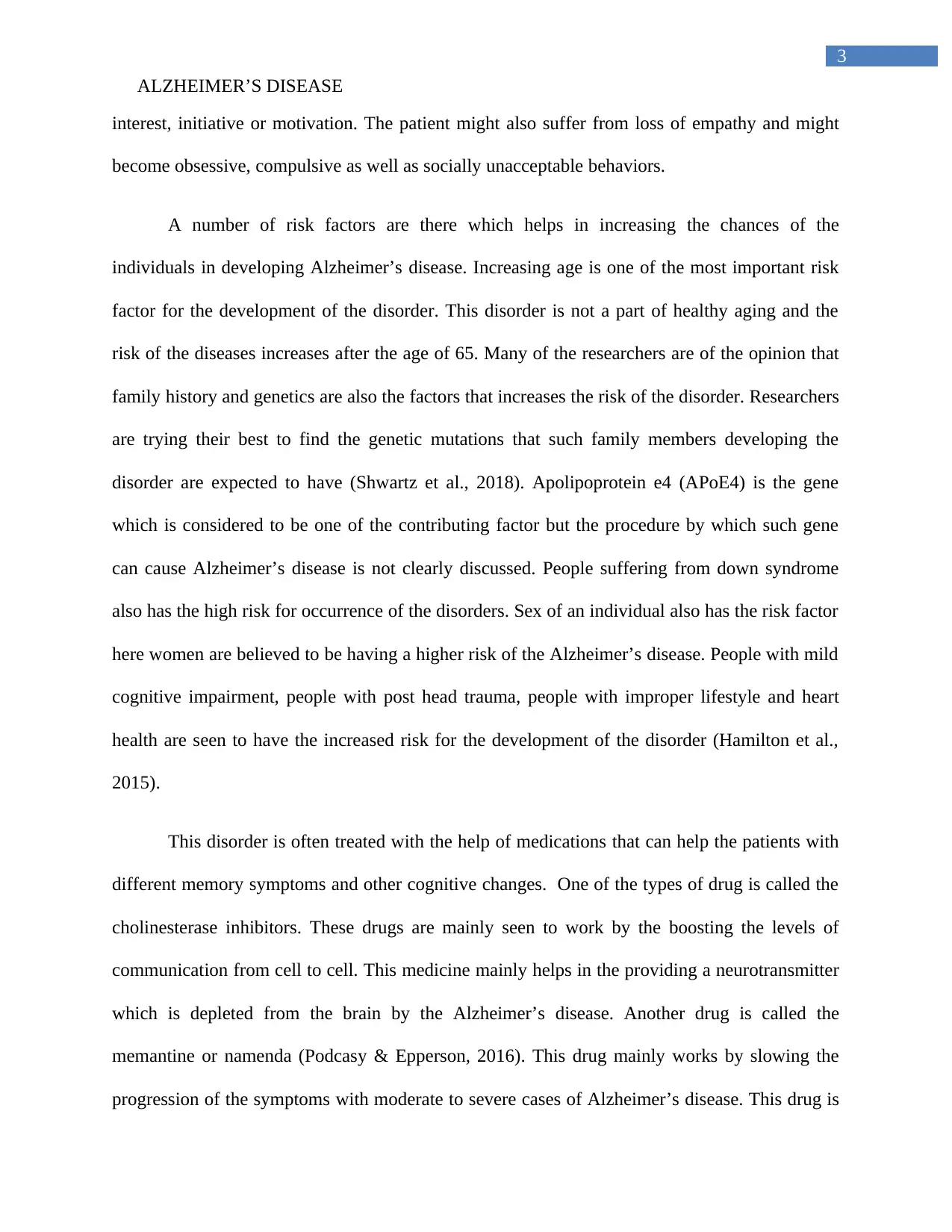
3
ALZHEIMER’S DISEASE
interest, initiative or motivation. The patient might also suffer from loss of empathy and might
become obsessive, compulsive as well as socially unacceptable behaviors.
A number of risk factors are there which helps in increasing the chances of the
individuals in developing Alzheimer’s disease. Increasing age is one of the most important risk
factor for the development of the disorder. This disorder is not a part of healthy aging and the
risk of the diseases increases after the age of 65. Many of the researchers are of the opinion that
family history and genetics are also the factors that increases the risk of the disorder. Researchers
are trying their best to find the genetic mutations that such family members developing the
disorder are expected to have (Shwartz et al., 2018). Apolipoprotein e4 (APoE4) is the gene
which is considered to be one of the contributing factor but the procedure by which such gene
can cause Alzheimer’s disease is not clearly discussed. People suffering from down syndrome
also has the high risk for occurrence of the disorders. Sex of an individual also has the risk factor
here women are believed to be having a higher risk of the Alzheimer’s disease. People with mild
cognitive impairment, people with post head trauma, people with improper lifestyle and heart
health are seen to have the increased risk for the development of the disorder (Hamilton et al.,
2015).
This disorder is often treated with the help of medications that can help the patients with
different memory symptoms and other cognitive changes. One of the types of drug is called the
cholinesterase inhibitors. These drugs are mainly seen to work by the boosting the levels of
communication from cell to cell. This medicine mainly helps in the providing a neurotransmitter
which is depleted from the brain by the Alzheimer’s disease. Another drug is called the
memantine or namenda (Podcasy & Epperson, 2016). This drug mainly works by slowing the
progression of the symptoms with moderate to severe cases of Alzheimer’s disease. This drug is
ALZHEIMER’S DISEASE
interest, initiative or motivation. The patient might also suffer from loss of empathy and might
become obsessive, compulsive as well as socially unacceptable behaviors.
A number of risk factors are there which helps in increasing the chances of the
individuals in developing Alzheimer’s disease. Increasing age is one of the most important risk
factor for the development of the disorder. This disorder is not a part of healthy aging and the
risk of the diseases increases after the age of 65. Many of the researchers are of the opinion that
family history and genetics are also the factors that increases the risk of the disorder. Researchers
are trying their best to find the genetic mutations that such family members developing the
disorder are expected to have (Shwartz et al., 2018). Apolipoprotein e4 (APoE4) is the gene
which is considered to be one of the contributing factor but the procedure by which such gene
can cause Alzheimer’s disease is not clearly discussed. People suffering from down syndrome
also has the high risk for occurrence of the disorders. Sex of an individual also has the risk factor
here women are believed to be having a higher risk of the Alzheimer’s disease. People with mild
cognitive impairment, people with post head trauma, people with improper lifestyle and heart
health are seen to have the increased risk for the development of the disorder (Hamilton et al.,
2015).
This disorder is often treated with the help of medications that can help the patients with
different memory symptoms and other cognitive changes. One of the types of drug is called the
cholinesterase inhibitors. These drugs are mainly seen to work by the boosting the levels of
communication from cell to cell. This medicine mainly helps in the providing a neurotransmitter
which is depleted from the brain by the Alzheimer’s disease. Another drug is called the
memantine or namenda (Podcasy & Epperson, 2016). This drug mainly works by slowing the
progression of the symptoms with moderate to severe cases of Alzheimer’s disease. This drug is
Paraphrase This Document
Need a fresh take? Get an instant paraphrase of this document with our AI Paraphraser

4
ALZHEIMER’S DISEASE
sometimes used in combination with that of cholinesterase inhibitor. Healthcare professionals
also can take several steps for supporting the sense of well being of the patient and continued
ability for functioning. The important objects of the patients should be kept near to the patent
within his reach and within his visibility. Use alarm clocks or different reminders or help the
patient be aware of the different actions he needs to take or important information that needs to
be conveyed to him. Excess of furniture, clutters and throw rugs need to be removed. Installation
of the sturdy handrails on the stairways as well as in the bathrooms can be helpful. Many of the
researchers are of the idea that regular exercise should also be included in the wellness plan of
the patient. Activities such as daily walk can help in development of mood and also helps in the
maintenance of the health of the joints as well as muscles and heart (Faisal & Bhuiyan, 2016). It
also helps in the promotion of restful sleep and thereby helps in prevention of the constipation.
Nutrition is another important arena that needs to be looked as the patients may forget to have
meals affecting their nutrients and forget to have drinks that affect their hydration. Therefore,
high calories healthy shakes and smoothies should be suggested for them. Water, juice and other
such healthy beverages should also be provided.
From the above discussion, it becomes clear that Alzheimer’s disease is one of the
progressive neural disorders that affect the cognitive power of individuals affecting their memory
and thinking capability. Their reasoning capability is lost and this affects their communication as
well as daily activities of their lives. Formation of plaques and tangles in the brain mainly result
in occurrence of the disorders. Different medications, risk assessment and proper environmental
modification, exercises and diet management can help individuals to slower the rate of the
progress of the disorder but cannot reverse it anyhow.
ALZHEIMER’S DISEASE
sometimes used in combination with that of cholinesterase inhibitor. Healthcare professionals
also can take several steps for supporting the sense of well being of the patient and continued
ability for functioning. The important objects of the patients should be kept near to the patent
within his reach and within his visibility. Use alarm clocks or different reminders or help the
patient be aware of the different actions he needs to take or important information that needs to
be conveyed to him. Excess of furniture, clutters and throw rugs need to be removed. Installation
of the sturdy handrails on the stairways as well as in the bathrooms can be helpful. Many of the
researchers are of the idea that regular exercise should also be included in the wellness plan of
the patient. Activities such as daily walk can help in development of mood and also helps in the
maintenance of the health of the joints as well as muscles and heart (Faisal & Bhuiyan, 2016). It
also helps in the promotion of restful sleep and thereby helps in prevention of the constipation.
Nutrition is another important arena that needs to be looked as the patients may forget to have
meals affecting their nutrients and forget to have drinks that affect their hydration. Therefore,
high calories healthy shakes and smoothies should be suggested for them. Water, juice and other
such healthy beverages should also be provided.
From the above discussion, it becomes clear that Alzheimer’s disease is one of the
progressive neural disorders that affect the cognitive power of individuals affecting their memory
and thinking capability. Their reasoning capability is lost and this affects their communication as
well as daily activities of their lives. Formation of plaques and tangles in the brain mainly result
in occurrence of the disorders. Different medications, risk assessment and proper environmental
modification, exercises and diet management can help individuals to slower the rate of the
progress of the disorder but cannot reverse it anyhow.

5
ALZHEIMER’S DISEASE
References:
Burke, A., Hall, G. R., Yaari, R., Fleisher, A., Dougherty, J., Young, J., ... & Tariot, P. (2015).
Managing Patients with Alzheimer’s Disease and Related Dementias. In Pocket
Reference to Alzheimer's Disease Management (pp. 51-79). Springer Healthcare,
Tarporley.
Faisal, F., & Bhuiyan, S. A. (2016). Disease Identification from Unstructured User
Input (Doctoral dissertation, IUT, CSE).
Griffin, J. W., & Bradshaw, P. C. (2017). Amino Acid Catabolism in Alzheimer’s Disease Brain:
Friend or Foe?. Oxidative medicine and cellular longevity, 2017.
Hamilton, G. F., & Rhodes, J. S. (2015). Exercise regulation of cognitive function and
neuroplasticity in the healthy and diseased brain. In Progress in molecular biology and
translational science (Vol. 135, pp. 381-406). Academic Press.
Morozova, M. A., Beniashvili, A. G., & Zapolsky, M. E. (2015). U.S. Patent Application No.
14/400,526.
Pistollato, F., Sumalla Cano, S., Elio, I., Masias Vergara, M., Giampieri, F., & Battino, M.
(2016). Associations between sleep, cortisol regulation, and diet: Possible implications
for the risk of Alzheimer disease. Advances in Nutrition, 7(4), 679-689.
Podcasy, J. L., & Epperson, C. N. (2016). Considering sex and gender in Alzheimer disease and
other dementias. Dialogues in clinical neuroscience, 18(4), 437.
Schwartz, L., Lafitte, O., & da Veiga Moreira, J. (2018). Toward a Reasoned Classification of
Diseases Using Physico-Chemical Based Phenotypes. Frontiers in physiology, 9, 94.
ALZHEIMER’S DISEASE
References:
Burke, A., Hall, G. R., Yaari, R., Fleisher, A., Dougherty, J., Young, J., ... & Tariot, P. (2015).
Managing Patients with Alzheimer’s Disease and Related Dementias. In Pocket
Reference to Alzheimer's Disease Management (pp. 51-79). Springer Healthcare,
Tarporley.
Faisal, F., & Bhuiyan, S. A. (2016). Disease Identification from Unstructured User
Input (Doctoral dissertation, IUT, CSE).
Griffin, J. W., & Bradshaw, P. C. (2017). Amino Acid Catabolism in Alzheimer’s Disease Brain:
Friend or Foe?. Oxidative medicine and cellular longevity, 2017.
Hamilton, G. F., & Rhodes, J. S. (2015). Exercise regulation of cognitive function and
neuroplasticity in the healthy and diseased brain. In Progress in molecular biology and
translational science (Vol. 135, pp. 381-406). Academic Press.
Morozova, M. A., Beniashvili, A. G., & Zapolsky, M. E. (2015). U.S. Patent Application No.
14/400,526.
Pistollato, F., Sumalla Cano, S., Elio, I., Masias Vergara, M., Giampieri, F., & Battino, M.
(2016). Associations between sleep, cortisol regulation, and diet: Possible implications
for the risk of Alzheimer disease. Advances in Nutrition, 7(4), 679-689.
Podcasy, J. L., & Epperson, C. N. (2016). Considering sex and gender in Alzheimer disease and
other dementias. Dialogues in clinical neuroscience, 18(4), 437.
Schwartz, L., Lafitte, O., & da Veiga Moreira, J. (2018). Toward a Reasoned Classification of
Diseases Using Physico-Chemical Based Phenotypes. Frontiers in physiology, 9, 94.
⊘ This is a preview!⊘
Do you want full access?
Subscribe today to unlock all pages.

Trusted by 1+ million students worldwide
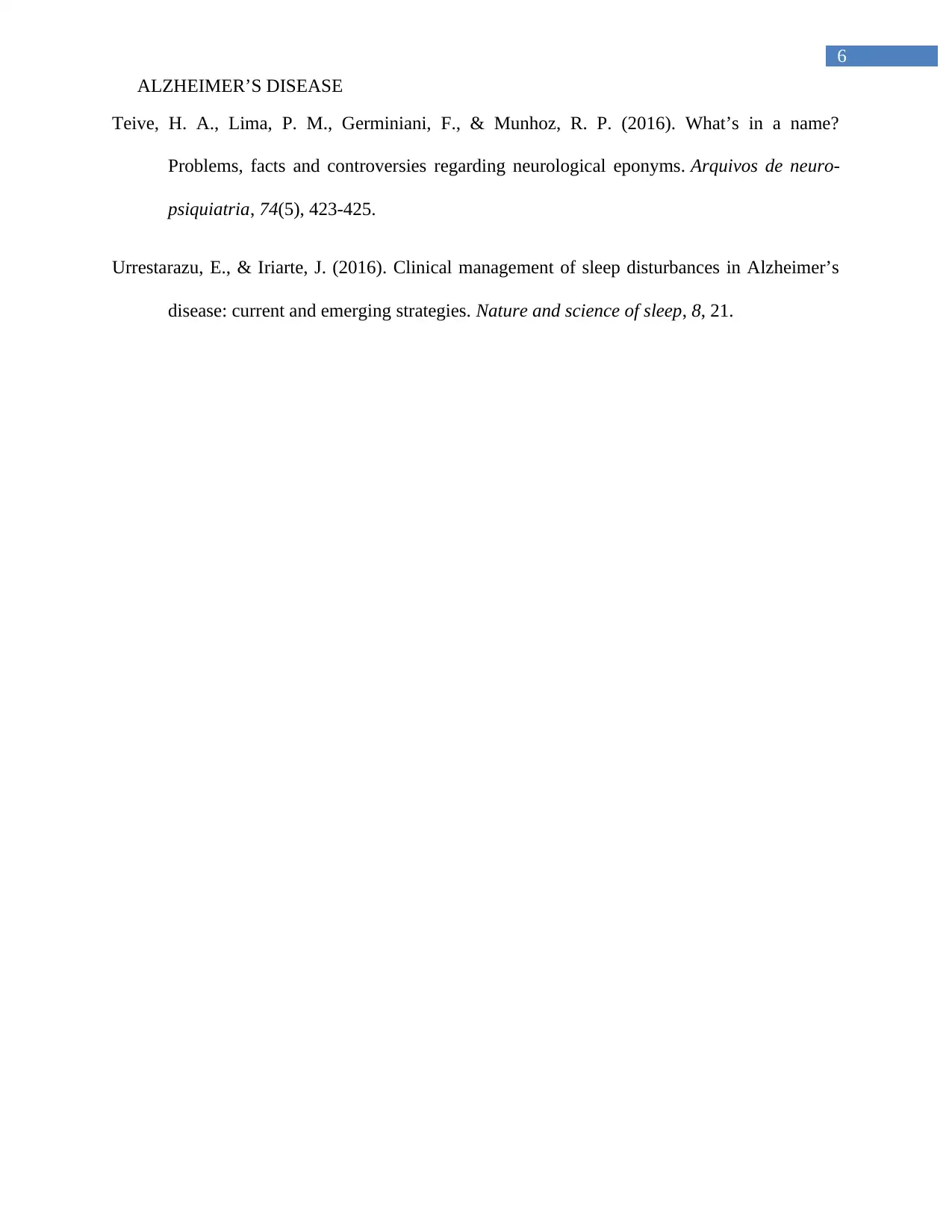
6
ALZHEIMER’S DISEASE
Teive, H. A., Lima, P. M., Germiniani, F., & Munhoz, R. P. (2016). What’s in a name?
Problems, facts and controversies regarding neurological eponyms. Arquivos de neuro-
psiquiatria, 74(5), 423-425.
Urrestarazu, E., & Iriarte, J. (2016). Clinical management of sleep disturbances in Alzheimer’s
disease: current and emerging strategies. Nature and science of sleep, 8, 21.
ALZHEIMER’S DISEASE
Teive, H. A., Lima, P. M., Germiniani, F., & Munhoz, R. P. (2016). What’s in a name?
Problems, facts and controversies regarding neurological eponyms. Arquivos de neuro-
psiquiatria, 74(5), 423-425.
Urrestarazu, E., & Iriarte, J. (2016). Clinical management of sleep disturbances in Alzheimer’s
disease: current and emerging strategies. Nature and science of sleep, 8, 21.
1 out of 7
Related Documents
Your All-in-One AI-Powered Toolkit for Academic Success.
+13062052269
info@desklib.com
Available 24*7 on WhatsApp / Email
![[object Object]](/_next/static/media/star-bottom.7253800d.svg)
Unlock your academic potential
Copyright © 2020–2025 A2Z Services. All Rights Reserved. Developed and managed by ZUCOL.




